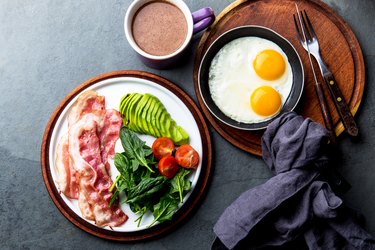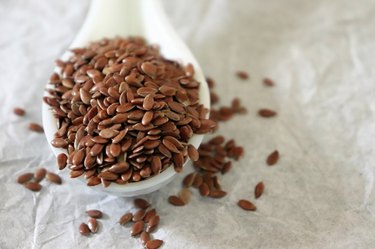
Perhaps you've heard about the keto diet and its promise to help you lose weight quickly. But how much do you really know about this trendy eating style?
Here, we'll cover the basics, including what the plan really does to your body, keto diet advantages and disadvantages and what to eat.
What Is the Keto Diet?
A ketogenic diet is low in carbohydrates, moderate in protein and high in fat. This type of eating style has become increasingly popular for weight loss in recent years, but it has been studied and used clinically for the treatment of epilepsy since the 1920s, according to a September 2018 article in the Indian Journal of Medical Research.
There are different types of keto diets, but here is a typical breakdown of the macronutrients you'll eat every day, according to the Harvard T.H. Chan School of Public Health:
- 70 to 80% fat
- 10 to 20% protein
- 5 to 10% carbohydrates
For instance, someone on a 2,000-calorie diet will eat about 165 grams of fat, 75 grams of protein and 40 grams of carbohydrates each day (for reference, one regular-sized bagel has about 47 grams of carbs, per the USDA).
The type of keto diet someone chooses may depend on their medical issues, weight-loss goals, athletic performance or other factors.
In general, though, people typically only follow a keto diet temporarily for fat-reduction and muscle-building purposes. Only those with certain medical conditions like epilepsy may need to continue keto in the long-term, per the Cleveland Clinic.
What Is Ketosis?
Keto involves an extreme reduction in carbs. This induces ketosis, which is when your body has insufficient glucose (sugar) to convert into energy and must use fat instead, according to the Harvard T.H. Chan School of Public Health.
Here's how that works: In ketosis, your liver processes fat to produce substances called ketone bodies, which your body then burns in lieu of glucose.
What Is Ketoacidosis?
Ketosis and ketoacidosis are often used interchangeably. But ketoacidosis refers to a condition where your body over-produces ketones and makes your blood dangerously acidic, according to the Harvard T.H. Chan School of Public Health.
This is typically only a concern for people with type 1 diabetes, who don't have enough insulin to regulate ketone production.
Potential Health Benefits of Keto
The diet was originally developed to help manage treatment-resistant epilepsy, and is still used for that purpose today. Other potential keto diet advantages include:
1. It May Help With Weight Loss
At first, ketosis may cause flu-like symptoms (more on that later), per Harvard Health Publishing. But once your body adjusts, you may experience some of the benefits of ketosis, such as weight loss.
A ketosis diet triggers your body to burn more fat, which can reduce excess fat stores, according to August 2013 research in the European Journal of Clinical Nutrition. It can also decrease your appetite while increasing satiety, which may prompt you to eat fewer calories and ultimately lead to weight loss, per the research.
2. It May Help Manage Type 2 Diabetes
While there's no long-term research that conclusively shows it's effective for medical conditions outside of seizure control, preliminary research on keto has found it may help manage other health problems like obesity and type 2 diabetes, according to a December 2019 paper in The Journal of Nutrition.
People with type 2 diabetes have insulin resistance, which is where your body's cells can't adequately use glucose for energy and leave it to build up in the blood. But restricting carbs, like on the keto diet, may improve or eliminate symptoms of insulin resistance, according to the European Journal of Clinical Nutrition research.
3. It May Support Brain Health
There may also be cognitive keto diet benefits. For instance, keto was found to improve working memory, visual attention and the ability to switch between tasks in older adults, according to one small, short-term August 2016 study of 19 people in Psychopharmacology.
There's also some research to suggest that keto may help you manage neurological issues like Alzheimer's disease, migraines and glioma, per a September 2018 review in Neurotherapeutics.
However, more and longer-term research is needed to better establish these links.
Risks and Disadvantages of the Keto Diet
Despite the purported benefits, there are disadvantages to the ketogenic diet, such as:
1. It's Very Strict
Keto can be difficult to follow, especially for long periods of time, according to the Harvard T.H. Chan School of Public Health. The highly specific allocation of macronutrients can also make it difficult to dine out or plan meals on the fly.
2. It May Not Be Heart-Healthy
Another drawback of the keto diet is that it might not be heart-healthy or sustainable in the long term due to the high amounts of fat you'll eat on the plan.
This can make it particularly difficult to avoid eating too many trans or saturated fats, which can increase your cholesterol levels and put you at risk for heart disease, according to the American Heart Association (AHA).
3. Ketosis May Come With Side Effects
The vast majority of people find that the primary con of the keto diet and ketosis is how your body initially reacts to the elimination of carbohydrates. This is commonly known as "keto flu."
Though the cause of keto flu is unclear, it may have to do with your body's response to carbohydrate withdrawal or changes in your gut microbiome, according to Harvard Health Publishing. You may experience an array of symptoms, including:
- Headache
- Brain fog
- Fatigue
- Irritability
- Nausea
- Constipation
- Difficulty sleeping
- Dizziness
Drink plenty of water and eat often to help mitigate these side effects until your body adjusts, per Harvard Health Publishing.
4. It's Easy to Fall Out of Ketosis
This diet is strict, so eating foods that aren't keto-friendly — like sources of carbs or sugar — can cause you to fall out of ketosis. Per the Cleveland Clinic, coming out of ketosis without a proper transition period can lead to:
- Weight gain
- Bloating
- Blood sugar spikes
- Increased appetite
- Sugar addiction
5. Ketosis Can Put You At Risk for Certain Health Conditions
Another keto disadvantage is that people who adhere to the diet for the long haul may be more at risk for certain health conditions.
For instance, the keto way of eating can lead to low blood pressure, constipation, kidney stones and nutrient deficiencies, according to UChicago Medicine.
Warning
Avoid the keto diet if you're pregnant, vegan or have an eating disorder, as you likely won't get all the nutrients you need.
Foods to Eat
Though the diet is restrictive, there are still plenty of keto-friendly foods to include in your meals. Here are some of the best foods to eat on a keto diet:
- Meat (though be sure to limit meats that are high in saturated fat, like bacon and sausage)
- Poultry
- Fatty fish like tuna, salmon and sardines
- Eggs
- High-fat oils like coconut, olive and MCT oil
- Avocados
- Nuts and nut butter
- Almond, coconut or konjac flour for baking
- Full-fat yogurt
- Whole milk feta cheese
You can also limit your intake of trans and saturated fats by sticking to a mostly plant-based keto diet, which can include vegetables like:
- Radishes
- Spinach
- Bell pepper
- Okra
- Green beans
- Eggplant
- Cabbage
- Bok choy
- Broccoli
- Arugula
- Artichoke
- Brussels sprouts
- Swiss chard
- Kale
Foods to Avoid
On the flip side, it's important to eliminate most sources of carbs, sugars and starches on the keto diet. Here are the foods to avoid:
- Sugary foods like candies, cakes, cookies and soda
- High-carb fruits like bananas and grapes
- Starchy vegetables like potatoes, sweet potatoes and squash
- Whole grain and wheat products like rice, bread and pasta
- Legumes like lentils, beans and peas
Tip
Just make sure not to restrict your carbs more than necessary, which can result in a lack of fiber and resulting constipation, according to Northwestern Medicine.
How to Get Started
Research is still limited on the keto diet and it has the potential to cause serious issues, so be sure to speak with your doctor to decide if it's a good fit for you before you try a ketogenic plan.
If the keto diet is safe for you, the most important step is to sharply reduce your carb intake to the recommended daily amount, according to an August 2021 StatPearls article. From there, it may take up to three weeks for your body to enter ketosis, per the Mayo Clinic.
Sample Meal Plan
Staying in ketosis requires that you stick to low-carbohydrate, high-fat diet proportions. Most people following a keto diet distribute their fats, proteins and carbohydrates in a way that helps them feel satiated throughout the day.
Assuming you're eating three meals a day, aiming for 2,000 calories and following the typical keto diet, your macronutrients might break down like this:
- Breakfast: 35 g fat, 10 g protein and 8 g carbohydrates
- Lunch: 60 g fat, 30 g protein and 14 g carbohydrates
- Dinner: 50 g fat, 20 g protein and 15 g carbohydrates
- Snacks: 20 g fat, 15 g protein and 3 g carbohydrates
Here are some recipes to try on your keto plan:
- Breakfast: Keto Blueberry Muffins
- Lunch: Keto Carnitas Salad with Walnut Ricotta Avocado Toast on Almond Bread
- Dinner: Keto Chicken Enchiladas with Hemp Hearties
- Snacks: Primal Scotch Eggs
The Healthiest Way to Follow a Keto Diet
While there are few restrictions when it comes to high-fat foods on a keto diet, there's that catch: Eating too much trans and saturated fat can increase your risk for heart disease, per the AHA.
Accordingly, limit your intake of these fats. Most adults should try to avoid eating trans fats whenever possible, per the 2020-2025 Dietary Guidelines for Americans. And the AHA recommends that saturated fats make up only 5 to 6 percent of your daily calories (that amounts to about 13 grams max if you eat 2,000 calories per day).
Sources of saturated fat and trans fat to limit or avoid include:
- Butter
- Red meat
- Skin-on poultry
- Certain cheeses like goat, cheddar and Swiss
The fix? Prioritize eating sources of beneficial fat such as:
- Avocados
- Tofu
- Salmon
- Nuts and nut butters
- Flaxseed oil


